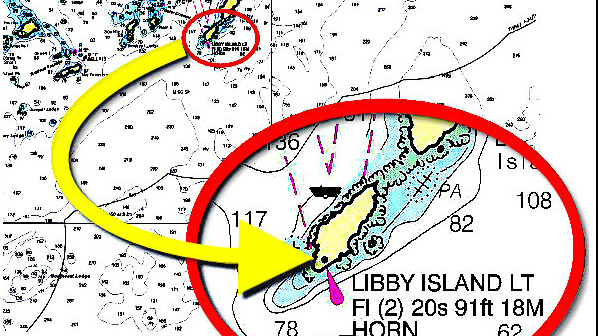You’re coming into a harbor and your electronics aren’t working (believe me, it happens). You need to figure out how far away you are from making a landfall. Here is some great advice from Skipper Tips about how to figure this out on your own:
In a pitch black night, you squint through the binoculars to try to pick up Libby Island lighthouse off the rugged coastline of Maine. The nautical GPS shows you dead on track and the light should be visible from 18 miles (note the abbreviation 18M). Right now, you estimate you are just about 18 nautical miles away from the light. And yet–nothing but blackness ahead or off the bow to port or starboard!
What could be wrong with your navigation? You might think on a perfect night with great visibility, you can see twenty miles or more? Would you believe that on many small boats, the distance to your visible horizon may be just three to four nautical miles? The curvature of the earth limits how far you can see. That horizon will be a lot closer than you think! Follow these easy sailing tips to solve this mystery fast ‘n easy…
1. Estimate your height.
How far are your eyes above the water surface? Estimate your height of eye (HE). Stand on the top of the coach roof to raise your HE and you will be able to see further away. If you have mast steps (or ratlines), you can increase the distance to your horizon by much more. Go to the next step to find out how to do this…
2. Calculate your Horizon Distance.
Take the square root of your height of eye (HE) and multiply it by 1.17. (note, some navigators use a slightly different factor from 1.17, but this factor will give you excellent accuracy) The result will be the theoretical distance to the horizon in good visibility.
3. Determine the Horizon Distance of the Light.
Scan your chart for objects that have their heights written next to the light or object symbol. Look at this charted light. Note that the light characteristic shows the height of the light tower in feet. This figure will be stated in feet or meters. Use the same method described above to find this light’s “horizon distance” or the distance the light will project out onto the horizon in a straight line.
4. Find “Geographic Range” to Solve the Mystery.
Add both horizon distances together to find out how far away you see the object. This will give a distance called “geographic range.” Remember one important point in this calculation will be to treat each distance as a separate factor. In other words, do not just add your height and the height of the light together. Go to the next step to see just how to calculate this in less than one minute!
5. Work Through This Navigation Example.
Grab your handy calculator and work through this example. Use the opening example to figure out what may be the reason we have not yet sighted this lighthouse:
You estimate your height of eye to be 8 feet above sea level. Calculate your horizon distance: Square root of 8 feet = 2.8. 2.8 X 1.17 = 3.3 nautical miles.
The lighthouse on our nautical chart stands 91 feet high. Calculate the light’s horizon distance: Square root of 91 feet = 9.54. 9.54 X 1.17 = 11.2 nautical miles.
Add both distances together: 3.3 nautical miles + 11.2 nautical miles = 14.5 nautical miles. That’s it! So, why does the charted abbreviation show the light visible from 18 nautical miles? This theoretical distance does not consider the curvature of the earth. Our calculation does.
You will need to sail to within about 14.5 nautical miles of the light to see it. Right now, you are too far away. Of course, in some atmospheric conditions, you will sight the light or “loom” of the light from much further away than this.
Adjust your estimates of landfall sighting or estimated time of arrival as necessary based on the conditions where you are sailing. Weather, atmosphere, rolling and pitching and wave height all come into play with light visibility. Remember that you can raise your own height of eye to see farther over the visible horizon.
Read more: http://skippertips.com




